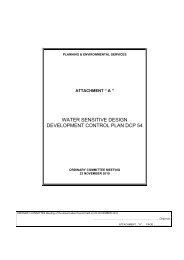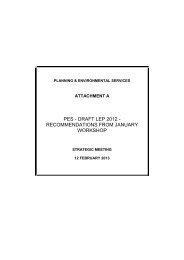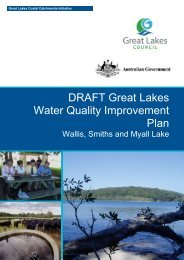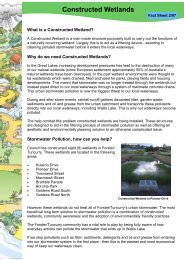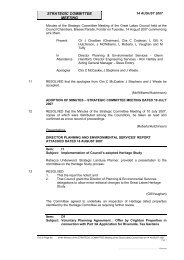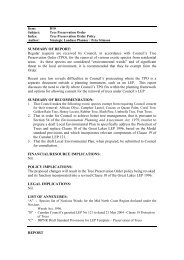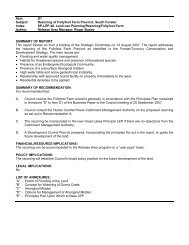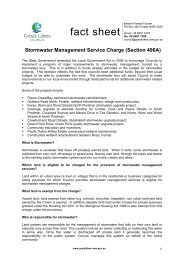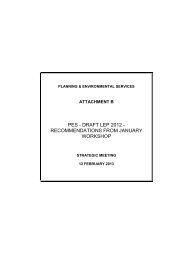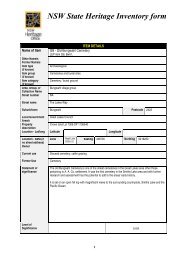smiths lake planning study volume 1: text - Great Lakes Council
smiths lake planning study volume 1: text - Great Lakes Council
smiths lake planning study volume 1: text - Great Lakes Council
You also want an ePaper? Increase the reach of your titles
YUMPU automatically turns print PDFs into web optimized ePapers that Google loves.
SOILS AND GEOTECHNICAL 4<br />
2 SOILS AND GEOTECHNICAL<br />
2.1 Introduction<br />
The objective of the soils and geotechnical component of the <strong>study</strong> is to describe the physical<br />
characteristics of the Smiths Lake Area and Smiths Lake Village Area and assess urban and<br />
land capability and formulate development guidelines. This component of the <strong>study</strong> and the<br />
preparation of this report has been undertaken by Robert Carr & Associates Pty Ltd and:<br />
• Outlines the geology, physical properties and distribution of soil and rocks within the <strong>study</strong><br />
area with particular emphasis on acid sulphate soils.<br />
• Assesses land and urban capability in terms of slope instability, high erosion potential,<br />
foundation conditions and acid sulphate soils.<br />
• Provides geotechnical management guidelines for urban and low low-scale development.<br />
The area of the <strong>study</strong> has been classified into two areas, the Smiths Lake Area (SLA) and the<br />
Smiths Lake Village Area (SLVA). The SLA and the SLVA contain a variety of landforms and<br />
vegetation, including steep headlands and slopes to low-lying coastal and estuarine lands. The<br />
SLVA comprises an urbanised area of about 3 km 2 . The SLA includes 60km 2 , of which 38km 2<br />
comprises the shallow saline coastal lagoon, Smiths Lake with the remainder comprising forest,<br />
rural development and the small urban villages of Tarbuck Bay and Charlotte Bay.<br />
2.2 Methodology<br />
Investigation methodology has involved review of available background data, field mapping,<br />
drilling and sampling and laboratory testing of soil and groundwater samples.<br />
2.2.1 Background Data<br />
Background data relevant to the <strong>study</strong> area has been sourced from:<br />
• Webb, McKeown and Associates, 1998, Smiths Lake Estuary Process <strong>study</strong>.<br />
• Department of Land and Water Conservation (DLWC). Soil profiles from 11 locations<br />
throughout the <strong>study</strong> area have been sourced through the Soil Data System and are<br />
appended. Acid Sulphate Soil Risk Maps (Wooton, Pacific Palms, Myall Lake and Seal<br />
Rocks sheets at a scale of 1: 25,000) have been used in the acid sulphate soil assessment.<br />
• Department of Public Works & Services (DPWS), geotechnical investigations carried out<br />
between 1991 and 1996 for the Pacific Palms and Smiths Lake waste water and water<br />
supply infrastructure. Investigations included subsurface investigation with physical and<br />
chemical testing of soil and water samples.<br />
• Geological and groundwater data as outlined in the Geology of the Camberwell, Dungog<br />
and Buladelah 1:100,000 Sheet.<br />
SMITHS_LAKE_PLANNING_STUDY.DOC<br />
O C E A N I C S<br />
A U S T R A L I A




